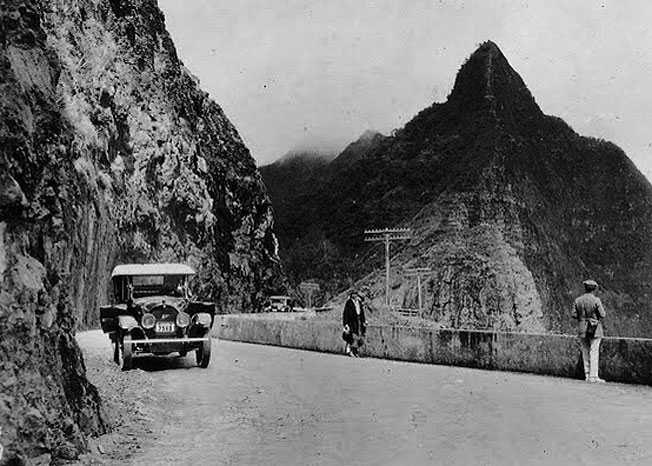The Pali Highway: From Rough Trail to Daily Commute
By Kristen Pedersen
Those of us who live on the windward side of Oahu zip back and forth to Honolulu on the Pali Highway without a moment’s thought. The 11 miles of highway that we now know so well is actually the third roadway constructed across and through the Koolaus and Nuuanu Valley. It connects Kailua and Kaneohe with Vineyard Boulevard in downtown Honolulu. Not so well known is that getting across this expanse wasn’t always so easy.
Before the highway or road existed, you had several options: take a canoe around the island; trek through the back of Kalihi Valley; or hike the most direct (and dangerous) route on a trail over the Pali cliffs.
In the early 1800’s, the cliffs trail was the main route farmers in the Kailua area used to bring produce to sell in the city and transport necessary goods back to the windward side. According to Kailua archaeologist Paul Brennan in his book KAILUA, the route was a scary series of “ropes and ladders where travelers had to climb straight up or down. Still, they trekked the trail every day, taking poi, fruits, sweet potato and pigs to residents of the city.”
In 1845, the narrow trail was widened to six feet and paved with large stones, allowing easier passage for horses and carts. This first Pali Road was a critically important improvement to the lives of farmers and their families, but as late as 1877, even with continued enhancements, was still not considered a safe passage.
In 1896, the legislature authorized the use of dynamite to widen the road for paving. A young engineer, Johnny Wilson, headed up the much-needed project. (Interesting side note: Wilson, a civil engineer and co-founder of the Democratic Party of Hawai‘i, would later be elected mayor of Honolulu.) Another widening and paving project just after 1900 allowed for automobiles and trucks to travel the road. By 1931, more than 2000 cars were navigating the 22 hairpin turns of the Old Pali Highway every day.

John H. Wilson, 4th Mayor of Honolulu
As early as 1850, people were clamoring for a tunnel. It took just over one hundred years, but Nuuanu Pali tunnels eventually became a reality. There was serious discussion in 1937 but concerns over the expense delayed construction and then World War II forced all tunnel plans to be postponed until the war was over. Construction began in the mid-1950’s and the first tunnel was opened for one-way traffic in 1957. The second tunnel was completed in 1961 and the Pali Highway itself was officially dedicated in December of 1962.
The next time you’re stuck in traffic on the Pali, you can think about the history of this road and how it came to be the modern, well-traveled route we know today!
HHF Volunteer Writer Kristen Pedersen is a professor in Public Communication at Portland State University. Prior to finishing her PhD, she worked in film and television in Miami, Los Angeles, and Brussels, Belgium. She is a U.S. Coast Guard veteran, an avid researcher, and from a kama’aina family.
Source Material
Brennan, Paul. Kailua. Kailua Historical Society. 2010.
Chapin, Helen. The Pali Tunnel. Hawaiian Historical Society. Web. 6 August 2016.
https://www.hawaiianhistory.org/time-capsules/landmarks/the-pali-tunnel/
Cook, Lynn. From Rock to Road. GoKailua. 14 Nov 2013. Web. 6 August 2016.
http://www.gokailuamagazine.com/2013/11/history/rock-road/
Papacostas, C.S. The Pukas in the Pali. History and Heritage: 2001. American Society of Civil Engineers Hawaii Section. Web. 7 August 2016. http://www.ascehawaii.org/2001.html
United States Railroad Administration. Hawaii National Park. Web. http://npshistory.com/publications/railroad/booklet-havo.pdf


